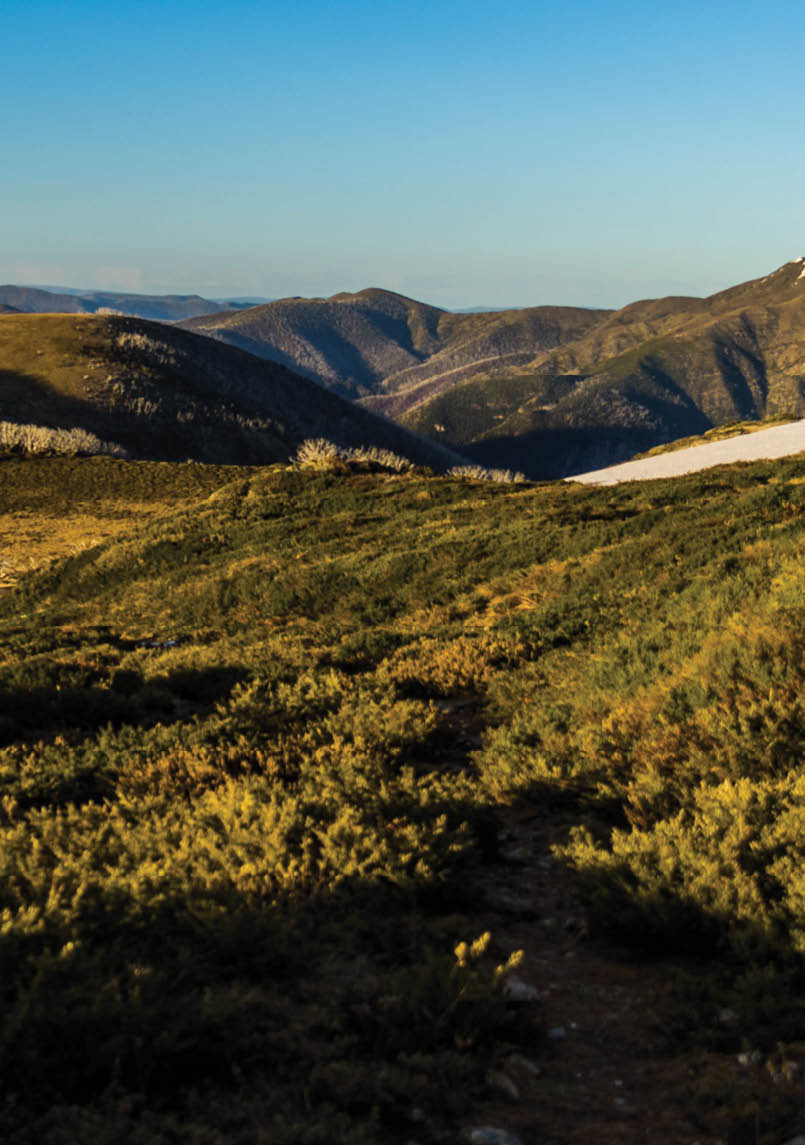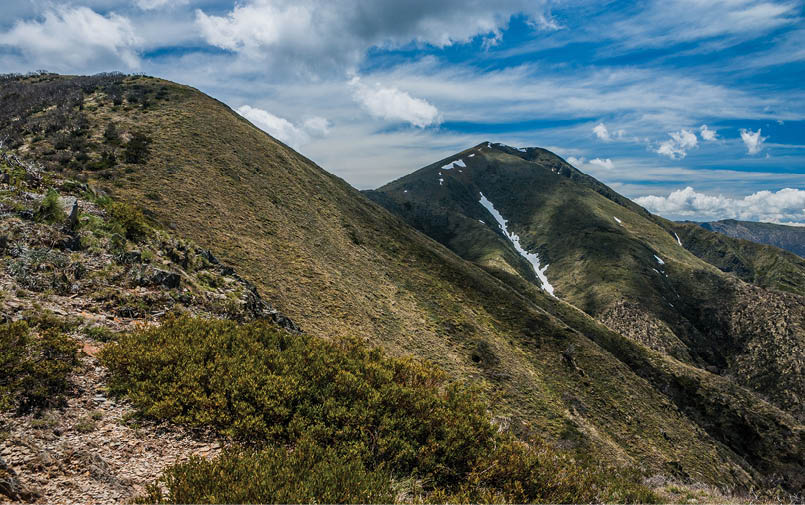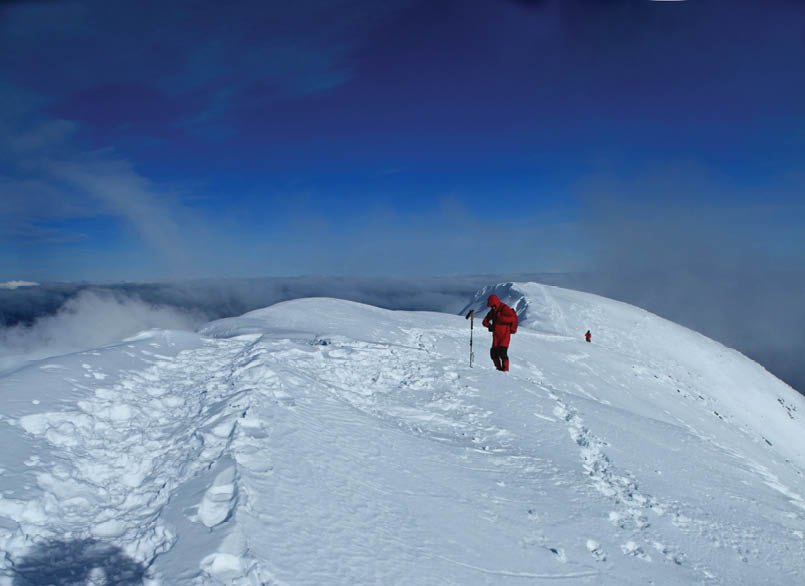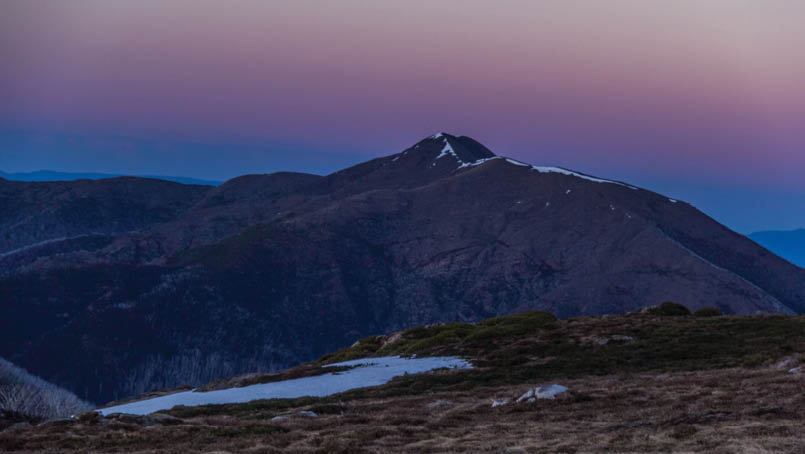

Falls Creek to Hotham Alpine CrossingDraft Plan
Stephen Lake


In April 2016 BWA had an article about the Falls Creek to Hotham Alpine Crossing (FHAC). There was a public consultation period, and in late November Parks Victoria released the Draft Master Plan (DMP). This is open for public comment until 19 December 2016. There's a discussion on the BWA website Falls Creek to Hotham Alpine Crossing. As the DMP was received only a few days before BWA was published, I cannot go into much detail. However, some general comments.
Feathertop from the Bogong High PlainsNorth-north-west
18 | BWA December 2016


The death of the bushwalkerExtinction is a slow process, it happens over time. A few groups here and there die off until one day there is simply silence. Usually extinction is caused through ignorance, but this time The Hon Lily D'Ambrosio, Minister for Energy, Environment and Climate Change is deliberately displacing adventurous bushwalkers from their spiritual homes to make room for cashed up tourists in our national parks.
National parks play many roles, and primarily they exist to protect nature. They are also a place for people to discover their adventurous spirit, to explore and re-connect with nature.
As bushwalkers we have been exploring these places for a long time. We know and love this land. We love to see others enjoying and caring for it. Each year we see our best bushwalks being turned into tourist theme parks, one by one.
The values of the parks are been sold off to the highest bidder. Private companies are
setting up lodges to cater for wealthy visitors. Bushwalking was once a pursuit for anyone willing to learn the skills and commit the time. The state government is turning it into a pursuit for the wealthy. Our national parks should be places where connection to nature speaks louder than the cash registers.
For decades many bushwalkers have roamed the hills around Mt Feathertop; we have all we need on our back and enjoy the quiet panoramic views from the ridge tops. The trip costs petrol money and food. If the Parks Victoria plan for the Falls Creek to Hotham Alpine Crossing goes ahead then people can pay $3500 for the trip. They will be able to stay in luxury lodges that are helicoptered in, and sip champagne on their private plot in the national park.
Slowly, walk by walk, our government is making it too expensive for the adventurous bushwalker as they turn our national parks into playground for the rich … The state government will tell you that bushwalkers are still welcome and that our national parks are large places. But we know ...
Climbing Diamantina SpurIan Mair
BWA December 2016 | 19


There are at least five major objections
The numbers are flawed. The current visitor numbers are well under those cited in the report.
It's making bushwalking very costly for no reason. Apart from the track being deep and then wet near Westons Hut, a few steps being desirable on Diamantina Spur and bare patches at Federation, most of the track and area are fine.
It seems that there's a plan to have 15 platforms for 30 people at Federation Hut, woefully short of current numbers. Present users will simply not fit and it will cost much more.
There's no free camping within 500 metres of the track. We may be permitted to camp if there's room. This and the Federation platforms and other aspects are an assault on the way we walk.
Glamping on Diamantina is the thin end of the wedge and does not meet the zoning. The resorts support the track.
Share this article, look at the forum, read the Draft Master Plan, and make a submission.
A solutionThis is not hard: make the route via Dibbins Hut and up Swindlers Spur. There would be minimal track maintenance and no need for any more platforms. Finish the walk at Mt Hotham, with an option to continue over Feathertop for those that want more, then down The Bungalow Spur. There would be no need to have any more infrastructure on Razorback, Diamantina Spur or Federation Hut. Let people camp where they always have, no restrictions. This would save quite a bit in initial and ongoing costs, and make the walk viable for a larger market segment. The steep and potentially dangerous Diamantina Spur ascent is now a much more gentle Swindlers Spur, emerging above the tree line an hour from the road.
The above saves money, makes the walk more attractive, and preserves the values.
More time, pleaseIt has taken PV and consultants many months to get to this stage, and now it is expected that respondents read 115 pages and reply in under four weeks just before Christmas when people will be preparing to go away or be away. It is unlikely that much will be done with the replies by early to
Feathertop from Diamantina Spur North-north-west
20 | BWA December 2016
mid-January. Hence, I suggest that putting back the DMP deadline to mid-January is indicated. I asked PV about this and did not receive a response. However, PV is probably swamped by requests for information, so a non-reply is understandable.
Our valuesThere's virtually nothing of import added by the infrastructure and a lot that is taken away. The DMP clearly evidences a lack of understanding of what we value and the terrain. Wild places attract and should be left as they are with minimal change, that only necessary to preserve or enhance the environment.
EconomicsIt's hard to see the economic case stacking up. Most people who go bushwalking overnight or longer drive to the walk area, do the walk and drive back. There are usually just two expenses: food and fuel. My experience has been that both are invariably distant from the walk area. For example, on a weekend trip from Melbourne to the Bogong High Plains, Friday night dinner would be on the Hume Freeway, where the car is fuelled. This is enough fuel to last until the return journey. There may be an ice cream in Mt Beauty on the Sunday. The DMP suggests that bushwalkers will spend time before and after the trip in the region. This may be the case for some but for the vast majority I suggest not.
However, the target market is not the adventure seeker like us. It is the cashed-up experience seeker who is willing to pay for the experience and may stay longer after at the tourist hubs or towns. Pages 8, 86 and 87 say the numbers of adventure seekers will decline because of the project but the experience seekers will rise, mostly coming from interstate and overseas.
On balance, the return on investment would not work. Is this another situation like Eastlink, where the figures were used by the Victorian Government in such a way as to obtain the outcome sought, only to be shown later to be demonstrably false? I asked for the figures to prove the ROI, no reply.
The numbersThe DMP says that there are 17,000 walker nights on the current walk each year. One experienced walker advised that this figure is fantasy. A count was made of the log book at Weston’s Hut 12 months ago and it does not reflect anywhere near these numbers. There is no way to accurately measure this 17,000 figure, most people will do variations but not the precise walk, and Diamantina Spur deters all but the most hardy. I was there at Easter a few years ago. Nobody on the western High Plains. A dozen people at Westons, one person at Blairs, a group of about eight descending Diamantina as I staggered up, and maybe 30 at Federation Hut. Spread over eight months, 17,000 walker nights is 4250 people, or 18 people every day at all campsites, or if they go just at weekends, over 100 every day. The 17,000 figure is false. I invite PV to prove this figure. Quickly. The page 59 graph gives some indication of the Cope Hut tent platform use and this does not reflect the numbers stated either.
Camping platforms at Federation HutCamping platforms are proposed for Federation Hut. The rules are that to use these platforms costs. Really, $31.60/night for one tent on a platform is about double what is paid at a caravan park with better shelter, flush toilets, hot showers and a shop. The DMP indicates that dedicated rangers will patrol the track and camp areas to enforce. PV staff do not like to enforce anything. Bushwalkers are on good terms with PV field staff. Is this to end? Free camping must be 100 metres away. At other places most people avoid the platforms and camp 100 metres away. Trouble is Federation is on a narrow spur, so everybody would have to pay. I wonder if they will pay.
So what we will see is Federation Hut with perhaps 15 platforms for 30 people. Fifteen tents? There's often been more than that at what is probably the most popular alpine campsite in Victoria. Only Cleve Cole Hut on Bogong might have more visitors.
The camping platforms have another problem. At present it's possible to fit tents tightly together when there are a lot of people. Platforms preclude this, much wasted space. PV plan to provide camping for 20 to 100 people at the top of Diamantina
“... the target market is not the adventure seeker like us. It is the cashed-up experience seeker who is willing to pay ...
BWA December 2016 | 21

spur and Federation Hut. Cannot be done, no room. I invite PV to say where the higher numbers will camp, and how such hordes fit with the remote nature of the region.
Dispersed campingPage 59 says that "Dispersed camping will be prohibited within 500 metres of the trail." Camping on Razorback is gone. Page 100 says that "Independent walkers who are prepared to follow a set itinerary are allocated a share, subject to availability." There's a like provision for those with no set itinerary. How generous. Until now there was always room for another, and being crowded out was rarely an issue. What about people that decide to go just before the trip? Will PV respond quickly? I suspect not. This is effectively paying a fee to have staff manage the fee process. The plan also states it will cater for current users but they will have to pay now. Page 100 shows how the system will be preferenced. This plan is nothing less than an end to our freedom of the hills. It ain't broke so don't fix it.
Diamantina Spur The proposed shelter near the top of Diamantina Spur will compromise a beautiful campsite to “take advantage of the views” and require fees to camp there. This is still proposed as a glamping spot with demountable structures run by private business so they will be staffed and serviced by helicopters. Maybe FIFO glampers.
Equally bad, helicopters are needed to service this “roofed facility”. Come again? This is a Conservation zone, defined as "Areas of high natural value where the emphasis is on protection of the environment." How do shelters and helicopters meet the zone requirements? The structures have to be approved by DELWP and fit the zone. Has approval been given? There is talk of en-suites for these structures, which means a septic system or something to contain the grey water. More cost.
Diamantina Spur is steep and long for most people. Those that can manage it do not need much more, although steps in sensitive
FeathertopNorth-north-west
22 | BWA December 2016
places may be useful. We do not want anything like Three Capes. Certainly have some walks for those less equipped for such things, but leave our wild places more or less intact. Seats at regular intervals seem to be planned.
A person not used to places like Diamantina Spur may be caught out by bad weather high on the spur when tired. The choices are unappealing. Continue higher becoming more tired as the walk goes into bad weather on an exposed ridge, or go down to the Kiewa West River, which is a long way from anywhere. There could be mobile phone reception from the upper Diamantina Spur to Hotham. In bad weather the only access is by foot four hours from the road, plus time for a rescue party to get there. If unfit people without adequate gear or experience are enticed into climbing Diamantina Spur by marketing then on balance there will be unhappiness. If so, those who support the idea should be held to account.
A well-known local advises that “Parks have received a lot of feedback from hikers seeking improved infrastructure.” I would like to see evidence of this. Can PV do so? I will ask; maybe we all should. PV has estimated 60,500 (camper nights) per year, or 165 people per day using the track. This is not bushwalking. It's a conveyor belt. We go to
wild places to get away from the madding crowds, not to be part of such hordes. The figure of 60,500 is doubtful. These figures make it look attractive to investors. Even 15,000 people a year is a lot.
The environmentThe projected numbers mean that toilets need to be every few hours on the track and much, much more capacity at the campsites. (I refuse to use the words “node”, and “trail”. Ghastly.) This is a lot of cost to build and maintain. If there are no toilets then we could well see a situation like the Overland Track which has bad faecal pollution. Water supplies will be compromised. The Razorback is zoned conservation. New buildings are contrary to this zone.
SummaryIn summary, the proposal is based on flawed maths, optimistic figures, costs too much, has a questionable ROI, breaches the zone requirements, pushes people out of traditional campsites, is hard to enforce, is dangerous, and will probably encourage civil disobedience. A viable alternative is available, costing much less and able to sustain more people without pushing traditional users out. Why not?
The writer would like to thank three people for checking the article and adding words, improving the article. You know who you are.

Feathertop from the Bogong High PlainsNorth-north-west
BWA December 2016 | 23